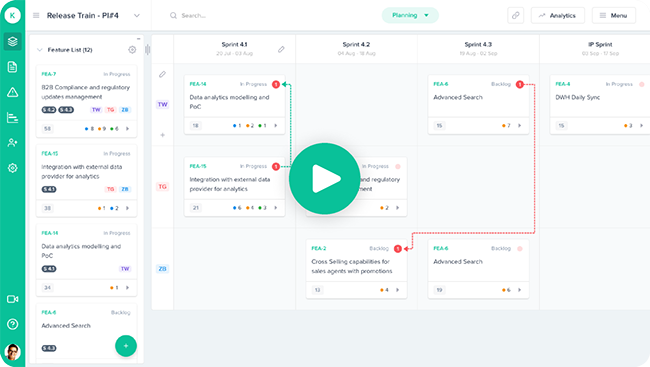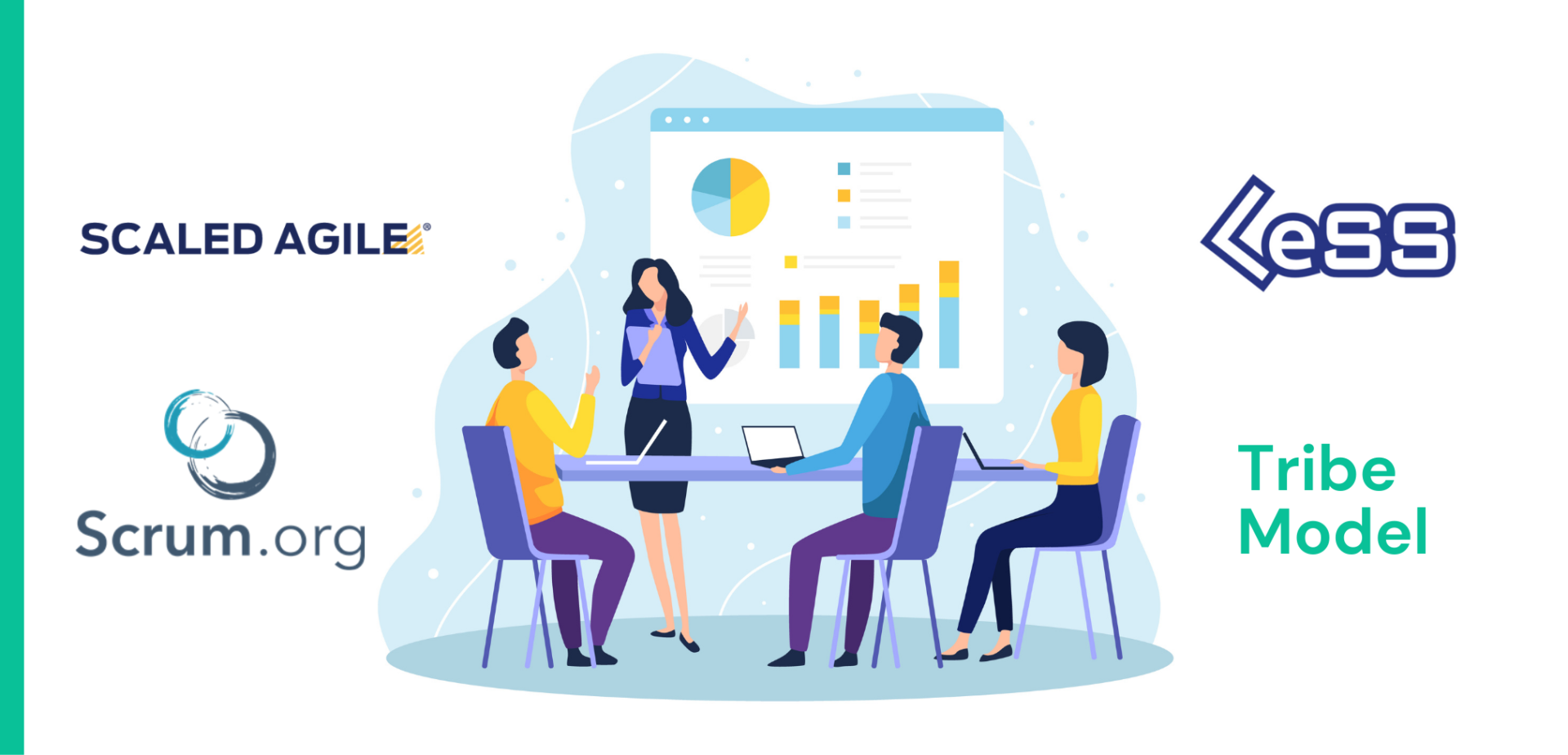1. What is Scaling Agile?
Scaling Agile is a systematic approach for achieving enterprise wide goals, by extending an organization’s existing implemented agile framework to multiple teams.
For an agile organization this means a commitment to collaborate over principles, practices, tools and teams to collectively strive towards the end goal of excelling at agile while pursuing an expansion of teams/ projects/ value streams.
2. Need to Scale Agile?
Scaling agile helps capture what the market actually needs.
3. When do you need to Scale Agile?
Ideally:
Right from the start of the Agile transformation.
Theoretically:
As soon as the complexity and scope of the project becomes large enough to require work of multiple resources.
Practically:
At any stage an organization is routinely experiencing:
- Lack of collaboration
- Business bottlenecks
- Stagnant or declining revenue
- Slower delivery cycles
- Complex processes
- Organizational friction
- Work in silos
- Bureaucratic hurdles
- System breaking from one team to another
These are all the telling symptoms of agile implementation in need of scaling.
At this stage you need an assessment to find out how fit your organization is for scaling agile. Seek executive level support to evaluate lack of specialized units such as design specialists, IT specialists, security specialists, stakeholder support etc. to determine what enterprise factors are blocking you from scaling agile.
4. Beginning to Scale Agile?
- Bottom up
- Top down
For a bottom up approach, you need to start scaling from the team level and go upwards to other teams and management in the organization.
This works perfectly for teams that are independent of each other’s work. But if the teams are dependent on each other, then you need to revaluate your strategy.
The top down approach is when the agile transition is embraced by the higher management first, and then it trickles down to the team level.
This can be better achieved by hiring a consultant or an agile coach that can guide you towards transitioning to scaling agile.
In either approach, the net transition structurally looks something like this: there are a number of small and multidisciplinary teams which work on a complex problem, by breaking it down into chunks. The teams provide solutions for each element of the chunks using swift minimum viable products and tight feedback loops. They then collaborate to integrate all these solutions into a coherent whole. The secret sauce of this collaboration is to ensure that it’s not the plan but responding to the change which is the kingpin. A definite metric to gauge the success of the process is the shift of focus from the output (such as lines of code or number of new products) to the outcomes (such as growth, revenue, and customer experience).
5. Assessment for Scaling Agile?
- What is your business strategy?
- How many projects are planned?
- How many teams will be working on them?
- What is the complexity of a single project?
- Are your current teams equipped and skilled enough to work on these projects?
- What works well? What needs to be improved?
- Does the current work culture support the change?
- What would be your KPIs for scaling agile?
- How well do your teams know agile?
- Will your teams be able to perform well in an agile environment?
- What would a successful transition look like?
- Have you identified any risks or dependencies that can affect your transition?
6. Popular Scaling Agile models?
Scaled Agile Framework (SAFe)
Scaled Agile Framework (SAFe) allows enterprises to accomplish their organizational goals to produce the highest quality product in the shortest sustainable amount of time. It is an approach that scales Scrum to an Enterprise Level and gives you the freedom to scale according to your business needs irrespective of the size of the enterprise, which could be as large as 000’s.
Apart from the traditional scrum roles, there are new and defined roles in SAFe such as the Release Train Engineer and Solution Engineer. There is also an addition of ceremonies and processes such as the PI Planning, execution of the Program Increment, Agile Release Train, Solution Train and so on.
It introduces a philosophy of servant and lean-agile leadership and goes beyond just implementing an organizational structure, rather instills a new mindset. You can read more about the range of roles in SAFe, here.
Disciplined Agile (DA)
Disciplined Agile Delivery (DAD) is an easy and flexible framework that provides context specific guidance that suits your enterprise needs to produce high quality products quicker. It is a hybrid model which is formed by a collection of the world’s proven Lean-Agile methods such as Scrum, Kanban, XP, Agile Modelling, Unified Process and many more.
DA addresses project delivery from its inception to delivering to its end users by breaking down the barriers between the development and other parts of the organization to bring everything into one single combined effort. It coordinates and aligns the scrum teams with the rest of the organization and their work so that everything remains transparent.
Large Scale Scrum (LeSS)
Large Scaled Scrum, abbreviated as LeSS, is one of the leading frameworks of agile software development. It is a multi-team scrum framework which can be applied to an agile team consisting of twelve, hundred or even thousands of individuals, all working together on one specific shared product.
Using LeSS you can create large or small sized products. It is a simple and minimalistic framework where there is less enforcement of rules, processes, roles or artefacts. There are only conventional scrum roles such as the product owner, scrum master and the team.
LeSS is very customer-centric as teams get to interact directly with the customer while the product owner focuses on setting the roadmap, priorities and the long-term vision of the product. You can read more about the range of roles in LeSS, here.
Tribe
Spotify’s popularized Tribe model has been a disruptor in scaling agile frameworks. Spotify, a popular music player, was launched in 2008 and has now grown to teams spread across multiple time zones. They owe their success to their deeply rooted agile methodologies and the utilization of scaling agile, with their own flavour.
The teams called “Squads” in the framework, use KANBAN, scrum sprints, XP or a mix of these agile methodologies to carry out their duties. You can read about the range of roles in Tribe model, here.
7. Benefits of Scaling Agile?
- Following consistent process and practices
- Getting executive support from stakeholders
- Using common tools across the teams
- Consultation or help from agile coaches
- Strong foundation of contextual agile knowledge
- Shorter time to market
- More flexible and responsive work environment
- Mutual respect for co-workers
- Increased overall productivity
- Decentralized decision making
8. Challenges in Scaling Agile?
Incomplete Understanding of the Framework
Many scaled agile transformations are doomed for failure even before they’re put into practice. The reason is threefold:
- Often the people leading the transformation wrongly assume that imposing a toolset will somehow magically transform their organization. In this case, the limitation of framework becomes the limitation of their scaled agile.
- Few organization leaders make the effort to understand the need profile of their business before adopting a particular scaling framework. This translates in them being ill-equipped when it comes to finer details of execution, and thus losing trust of the team.
- Ill-prepared leadership may also mean someone deciding to lead after completing a book or taking a quick course, without any experiential knowledge of how scaling agile unfolds through the ranks of an organization. This results in poorly implemented processes and faulty interpretation of principles.
Lack of Motivation to Change
Stepping out of one’s comfort corner is always difficult, moreso in the context of large organizations. Inertia is absolutely real. This means that once an organization is in for the change, the first item in their gear should be the motivation to not be daunted by the discomfort of new processes and unfamiliar grounds.
Forming a New Mindset
A major prerequisite when adapting to any scaling agile model is having a lean agile mindset. It is not just one person who needs to have it, it has to be embedded in the organizational DNA. Leaders need to internalize the concept of servant leadership where priorities of the teams are kept first. Teams need to be taught on how to take ownership of their work and should be empowered to take their own decisions.
Cultural Shift
In a traditional style of management, teams are confined to working within their silos following a hierarchical system. They are firmly dedicated to following the plan made by the higher management. With scaled agile, a new working culture has to be adopted.
It eliminates the idea of a top down hierarchy, does away with the silos and enhances transparency and collaboration between teams and management. Authority, no longer is centralized.
Adopting this culture takes time and is an uphill, but rewarding task. Mental shift towards embracing a culture where ownership is shared across the table needs a lot of work and a strong commitment with the cause of scaling agile.
Improper Tools
Building in silos is a deal breaker for agile. Organizations tend to use tools that differ across every department. This causes a disconnect.
Harmonizing the organizational technology stack is one of the biggest challenges of scaling agile. There needs to be a tracking tool that should be accessible to all. It should allow a transparent flow of information, promoting visibility and collaboration. This tracking tool shall allow you to create strategic plans, dependencies and risks. Kendis is one such solution that takes care of all the planning and tracking needs of its partners by ensuring that all their business processes are visible.
Remote teams
In the post pandemic world, remote scaling agile is not a novel concept anymore. It has its own set of challenges:
Multiple locations
Distributed teams
Cross-cultural communication
Increasing reliance on third-party technology enablers
These are just a few examples of challenges faced while scaling agile. Just like the challenges, there are a handful of myths around scaling agile as well. None of these challenges and myths are impossible to manage, however, these can be a tough nut to crack if your organization is not fully prepared to deal with them.
(Need to share these challenges with your team? Use our dedicated blog post on the subject.)
9. Duration it takes to Scale Agile?
Since there is no finite stage of scaled agile, it is safe to say that the more an organization matures in its scaling efforts, the better are the results.
Kendis offers the complete solution for your scaling agile needs


Program Boards
Collaboration, communication and transparency lie at the heart of Kendis. It brilliantly reduces all the painful efforts and makes the entire process of planning your Program Increment a very easy task.

Dependencies Management
Dependencies are essential in recognizing, identifying and correctly mapping factors that are affecting your progress. In Kendis you can create multiple dependencies across your Program board and track them.

Risks Management
With Kendis you can transparently address and visualize the present and upcoming risks of your Program Increment, sprint or iteration in a way that makes it painless to identify and analyze.

PI Objectives
Create objectives for each team or for your Program and link those with any item present your board. This allows you to choose precisely what features and stories are contributing to the objective.

Program Reports and Analytics
An extremely vital and powerful feature that gives an overview of all the recent activities that are being done. Presented in graphical or tabulated formats, you obtain all the necessary information in just a glance.
